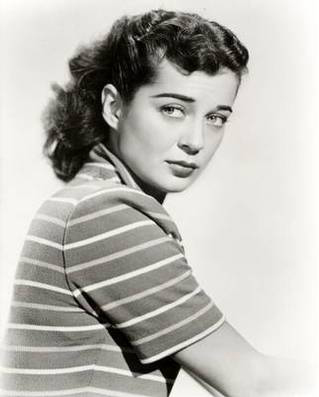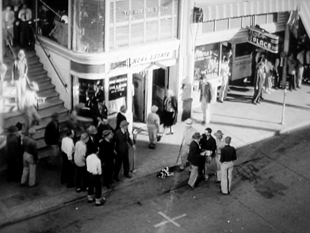
 |
|
|
|
Savant is disproportionately attracted to a number of movies made in the late 1940s and early 1950s, stories that make social criticism more than an idle remark or a sentimental gesture. Some of these pictures are films noir and others are basically social issue films, but all carry a discomfiting undercurrent. Each challenges the prevailing consensus opinion, the conformist mindset. They're critical, or angry, or they cry out 'for shame'. In one of the hottest periods of the Cold War pressure was brought to bear on Hollywood to present a positive image of America, so some of these pictures had to resign themselves to limited distribution: Pitfall -- something is wrong with marriage. Lost Boundaries -- racism is out of control. Force of Evil -- big business and organized crime are interchangeable. Intruder in the Dust -- Black Pride can't be intimidated. Try and Get Me! -- crime comes from a lack of opportunity; American citizens are a bloodthirsty mob. The Underworld Story -- the profit motive taints everything; miscarriages of justice are commonplace; the wealthy can get away with murder. The Prowler -- the promise of the Good Life will even corrupt policemen. The Well -- the average town is a racial tinderbox. 
I know basically good, responsible people that would judge the above pictures as "hate America" propaganda, a reaction that the HUAC exploited to hound many a filmmaker out of Hollywood. One of the most prominent was Joseph Losey, whose first film was the 'children's peacenik fable' The Boy with Green Hair. A definite liberal artist, Losey directed Charles Laughton in Galileo, a stage play with allegorical connections to the HUAC investigations. Losey's second feature directing effort, the Paramount release The Lawless, is an open attack on the myth of small-town values. With the love of simple pleasures and quiet nights comes small-mindedness about ethnic issues, rigorously denied (or celebrated) by the white majority. I've read about more than one fortunate European Jew that survived Nazi terror and was grateful to be able to relocate to America, only then to be appalled to see American blacks and Hispanics treated almost exactly as Jews were back in Germany. The Lawless is one of the first and the best postwar Hollywood movies to acknowledge that the problem of racial-ethnic prejudice even exists. Noted reporter Larry Wilder (Macdonald Carey) has given up his international journalism career to settle in "The Friendly Town" of Santa Marta, where he can escape the disheartening misery and injustice he's found abroad. His local paper The Morning Union avoids controversy where ever possible. Encouraged by a new friendship with Sunny Garcia (Gail Russell), a reporter for the much smaller Spanish paper La Luz, Larry goes against the advice of the town's power brokers (and his advertising clients) to come to the defense of poor Paul Rodriguez (Lalo Rios). The teenaged fruit picker is charged with rioting, striking a policeman, stealing a vehicle, causing a fatal traffic accident and attacking an innocent farm girl in a darkened barn. Larry intervenes to keep an armed posse from shooting Rodriguez, and then commits an apparently unpardonable act. With the farm girl's father and other racists already indiscriminately beating up Mexican-Americans, Larry writes an editorial asking for calm and suggesting that the unproven charges against Rodriguez are a symptom of hysteria. The editorial is enough to incite a mob to attack the offices of the Morning Union and destroy everything inside. I was a teenager in San Bernardino, California, where we white kids never ventured over to the Mount Vernon Avenue 'Mexican' side of town. The morning after some kind of a big street fight, I remember the local newspaper quoting the chief of police saying he'd shoot to kill if the incident was repeated. The Lawless begins with Larry and Sunny meeting at a modest fruit picker's dance. Rodriguez gets into a fight when rich developer's son Joe Ferguson (Johnny Sands) and his Anglo friends (Tab Hunter among them, in his first film) crash the dance and insult the Mexican girls that they expect to be "easy". In the melee that follows Rodriguez accidentally slugs a cop (amusingly, "Bo Creel" from the previous year's White Heat, Ian MacDonald). Rodriguez stupidly flees, stealing an ice cream truck as he goes. Captured, an out-of-control cop beats him in the back seat of a patrol car. The racist cop both causes the accident and then blames the death of the driver on Rodriguez. Frightened, Rodriguez hides in a barn. He never touches or even approaches the girl. By the time her father gets involved, the charge is attempted rape. 
Adapting his own novel, ace screenwriter Geoffrey Holmes doesn't paint Paul Rodriguez as faultless. In an earlier incident, Paul's friend Lopo Chavez (Maurice Jara) runs a stop sign and dents Joe Ferguson's car. Fighting words are immediately exchanged. The whole point of the dance is to celebrate a truce among various Mexican gangs and end the fights that give the whole community a bad name. All of the 'responsible' parties assume that the fight at the dance is more indiscriminate Mexican-American violence. Prejudice immediately leaps forward to brand Paul as a savage animal on the loose. Freelance reporter Jonas Creel (Guy "Herbert" Anderson) invents his own lurid details, making Paul's rampage sound so vicious that a TV crew arrives to cover the story. The TV people blurt out a constant flood of lies and exaggerations that incite a mob to form. Meanwhile, a cynical female reporter (Lee Patrick of The Maltese Falcon) encourages the farm girl to consider herself an outraged victim, and hypes the sick sex angle. Larry is advised to keep the white boys' names out of the scandal, and the backer of his newspaper warns him not to 'take sides' on the issue. Larry can't help it, not with Sunny standing by as his new conscience. Knowing he'll probably lose everything, he writes his editorial. Try and Get Me! makes a more damning, apocalyptic statement about the lack of human decency whenever a crowd forms, but The Lawless makes valid points about endemic racism in a less extreme situation. Joe Ferguson is immediately released on bail, whereas everybody advises the Mexican kids to plead guilty just out of practicality. They can't afford to do anything but pay their fines and beg for leniency... they can't afford self-respect or justice. MacDonald Carey brings with him associations from Alfred Hitchcock's Shadow of a Doubt, where he also played a city dweller impressed by the special qualities of small town life. Carey's Larry Wilder admits that he's a runaway from big-time journalism, where he got tired of "being told what to write" -- presumably under economic pressure. Carey would work for Joseph Losey again ten years later in These Are the Damned, playing another runaway from the American Rat Race who expects to find "La Dolce Vita" in Europe. The unhappy Gail Russell is a convincing morena and of the cast seems the most natural in her role. Her character Sunny does not spend the movie harping about injustice. She stops pressuring Larry when she realizes that he will risk all that he has if he takes an active role in the issue. 
Most interestingly, the script doesn't let Larry Wilder entirely off the hook either. He witnesses his journalist colleagues dictating gross lies and distortions about the incident to outside papers, and responds with a knowing smile. Did Losey not know how to direct these scenes, or was he trying to emphasize that dirty journalism is Business as Usual? Also interesting is the fact that the local financial big shot, usually the villain in movies of this kind, is a decent guy. Ed Ferguson (John Hoyt, neatly underplaying) criticizes his son Joe and quietly pays the bail for the Mexican arrestees. When Larry says he's quitting and leaving town, Ed offers to help him get his paper started again, because he thinks the town needs an honest citizen like Larry. There's not a hint of irony in Ed Ferguson's outreach. Like almost all of the pictures noted above, The Lawless joined the lists of "hard to see" movies not frequently broadcast. It would be fun to see what John McElwee might have to say about Savant's subjective take on this -- being who I am, I too readily envision pictures like The Lawless being yanked from syndication packages because of local complaints, or open prejudice. I myself saw it for the first time on TCM last year -- and I had been been trying to catch up with it since the early 1970s. 1 In addition to the abovementioned Tab Hunter, beautiful (and young!) Martha Hyer has a brief scene as an unhappy Friday night date, stuck in a dirty newspaper office. It's her twelfth picture. Olive Films' DVD of The Lawless is a good B&W transfer of this now-obscure thriller. Some mottling is visible every once in awhile on dark scenes but otherwise the show is in fine shape. Although no extras are included this is a fine and welcome addition to Savant's gallery of "damned" political movies: socially conscious films aimed at subverting complacent attitudes.
On a scale of Excellent, Good, Fair, and Poor,
The Lawless rates:
Footnote:
1. It's too easy to read one's own bias into raw information about what is picked up for TV broadcast and what is not. When researching Kiss Me Deadly I saw that it was added to, and then abruptly dropped from, a number of TV syndication packages in the late 1950s. I naturally wondered if the film's radical content was considered too liberal for the TV outlets that rejected it. More likely, the stations found it too violent, or perhaps too drab. TV prints of Kiss Me Deadly were not things of beauty; maybe the stations found the dialogue too hard to hear or the image too washed out ... who knows?
Reviews on the Savant main site have additional credits information and are often updated and annotated with reader input and graphics. Also, don't forget the 2011 Savant Wish List. T'was Ever Thus.
Review Staff | About DVD Talk | Newsletter Subscribe | Join DVD Talk Forum |
| ||||||||||||||||||